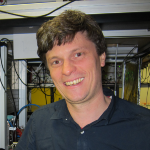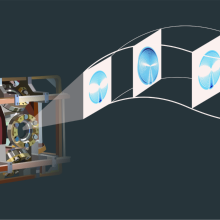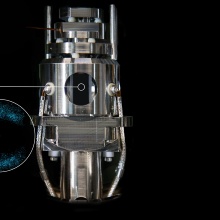Learn about...
The Project
This project aims at the spatially resolved investigation of ultracold Rydberg physics. To this end, our experimental apparatus is designed to combine the ability of producing ultracold quantum gases of rubidium and lithium with the controlled creation of individual Rydberg atoms. An ion microscope allows for the spatial resolution of the Rydberg atoms. Research goals are the investigation of strongly-interacting quantum matter and the creation of (heteronuclear) Rydberg molecules either as a microscopic correlation probe for degenerate quantum gases or as a novel tool to study ultracold ion-atom scattering.

Recently, we have proposed a novel experimental method to extend the investigation of ion-atom collisions from the so far studied cold regime to the unexplored ultracold regime. The key aspect of this method is the use of a Rydberg molecule to initialize the ultracold ion-atom scattering event. Together with M. Tomza and M. Tarana, we conducted simulations for the lithium ion-atom system which show how the initial Rydberg molecule wave function, freed by photoionization, evolves in the presence of the ion-atom scattering potential (see figure 1). We predict that the scattering length can be experimentally determined either from the velocity of the scattered wave packet or from the molecular ion fraction.
Our setup
Our experimental apparatus (see figure 2) is designed to produce ultracold quantum gases of rubidium and lithium. Starting with hot atomic beams from two ovens, the first slowing step is provided by a two-species Zeeman slower. Next, further cooling is achieved by a MOT which is followed by an optical transport of the cold atomic clouds to the science chamber where evaporation cooling in an optical dipole trap will finally yield ultracold trapped dilute atomic clouds.
An in-vacuum asphere and an electric field control (see icon) inside the science chamber will allow for the creation and control of single Rydberg atoms.
To efficiently detect the single Rydberg atoms, we will employ either electric field or photoionization. A Rydberg ion imaging system, consisting of an ion microscope (see icon) and a delay-line detector, will finally allow to record the Rydberg ions with temporal and spatial resolution.
Project Publications
2024
- M. Berngruber, D. J. Bosworth, O. A. Herrera-Sancho, V. S. V. Anasuri, N. Zuber, F. Hummel, J. Krauter, F. Meinert, R. Löw, P. Schmelcher, T. Pfau, In situ observation of non-polar to strongly polar atom-ion collision dynamics, Physical Review Letters 133, 83001 (2024).
2023
- Y.-Q. Zou, M. Berngruber, V. S. V. Anasuri, N. Zuber, F. Meinert, R. Löw, T. Pfau, Observation of Vibrational Dynamics of Orientated Rydberg-Atom-Ion Molecules, Phys. Rev. Lett. 130, 23002 (2023).
2022
- S. Tiwari, F. Engel, M. Wagner, R. Schmidt, F. Meinert, S. Wüster, Dynamics of atoms within atoms, New Journal of Physics 24, 73005 (2022).
- N. Zuber, V. S. V. Anasuri, M. Berngruber, Y.-Q. Zou, F. Meinert, R. Löw, T. Pfau, Observation of a molecular bond between ions and Rydberg atoms, Nature 605, 453–456 (2022).
2021
- C. Veit, N. Zuber, O. A. Herrera-Sancho, V. S. V. Anasuri, T. Schmid, F. Meinert, R. Löw, T. Pfau, Pulsed Ion Microscope to Probe Quantum Gases, Phys. Rev. X 11, 11036 (2021).
2020
- R. Mukherjee, F. Sauvage, H. Xie, R. Loew, F. Mintert, Preparation of ordered states in ultra-cold gases using Bayesian optimization, New Journal of Physics 22, 75001 (2020).
2018
- T. Schmid, C. Veit, N. Zuber, R. Löw, T. Pfau, M. Tarana, M. Tomza, Rydberg Molecules for Ion-Atom Scattering in the Ultracold Regime, Phys. Rev. Lett. 120, 153401 (2018).
We are looking for motivated new team members!
Project Team
Project News
Contact

Tilman Pfau
Prof. Dr.Head of Institute

Robert Löw
Deputy Director

Florian Meinert
Group Leader















